More than 65 million people, almost 30% of the population in the United States, are actively involved in providing 20 or more hours of care for a chronically ill, disabled, or aged family member or friend each week. As our population continues to age, this number is expected to grow rapidly.
The role of a caregiver is multifaceted and often involves tasks and skills beyond the education or comfort level of most providers. Some examples include; managing money, paying bills, shopping, cleaning, maintaining and repairing a home, dispensing and injecting medications, cleaning wounds, changing dressings, catheter management, bed baths, assisting in position changes, transferring from the bed to the chair, ambulation, stair climbing, bathroom assistance for toileting and showering and many other responsibilities. Consequently, a caregiver is often at risk for mental, spiritual and physical fatigue or breakdown. It is no surprise that depression, illness and injury often plague a caregiver and eventually, the caregiver is in need of a caregiver. One of the most common injuries suffered by a caregiver is back pain.
Lower back pain (LBP) is one of the most common problems in our society. Over 90% of all Americans will suffer from it at least once in their lives. It is generally agreed that prevention is the best treatment for LBP.
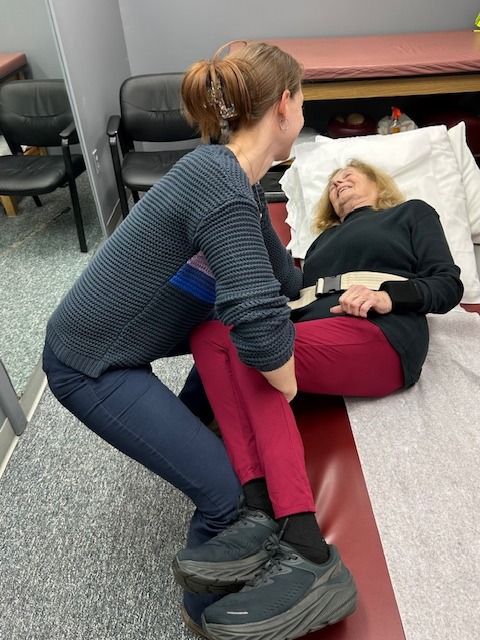
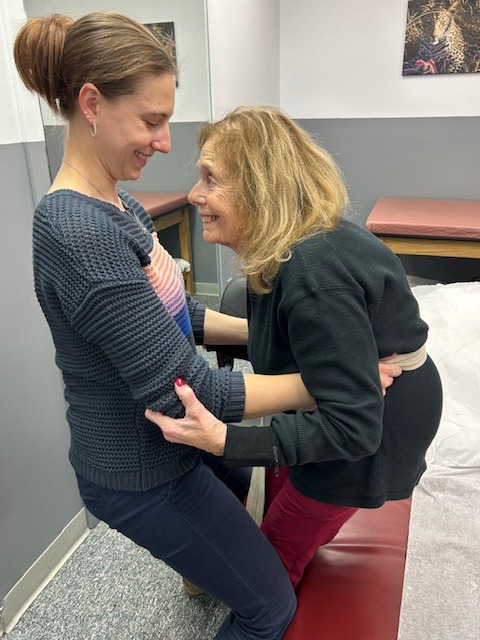
MODELS: Andrea Molitoris Kozlowski, PT, DPT, Associate Mackarey Physical Therapy, Doris Koloski, Scranton

EVERY MONDAY – Read Dr. Paul J. Mackarey “Health & Exercise Forum!” via Blog
EVERY SUNDAY in "The Sunday Times" - Read Dr. Paul J. Mackarey “Health & Exercise Forum!” in hard copy
This article is not intended as a substitute for medical treatment. If you have questions related to your medical condition, please contact your family physician. For further inquires related to this topic email: drpmackarey@msn.com
Paul J. Mackarey PT, DHSc, OCS is a Doctor in Health Sciences specializing in orthopedic and sports physical therapy in Scranton and Clarks Summit. Dr. Mackarey is in private practice and is an associate professor of clinical medicine at Geisinger Commonwealth School of Medicine. For all of Dr. Mackarey's articles, visit our exercise forum!

Ice baths have become a new trend or fad in health and fitness, especially among elite athletes and some celebrities. In fact, it is impossible to scroll through social media without encountering someone “taking the frigid plunge!” However, it is far from a new treatment modality. The Ancient Greeks employed cold-water immersion for fever, pain relief, relaxation and socialization. In fact, Hippocrates documented the use of cold for medicinal purposes for its analgesic benefits.
Ice baths, a type of cryotherapy, is also referred to as cold water immersion (CWI) or cold-water therapy, involves immersing your body in ice water for approximately 5-15 minutes from the neck down at a temperature of 50-59 degrees. The ice baths are commonly used for pain, delayed-onset muscle soreness (DOMS), and inflammation and mood elevation.
In theory, the cold water lowers the temperature of your skin and body by vasoconstriction (narrow) of the blood vessels. When you get out of the cold water the vasodilatation (widen) of the blood vessels immediately brings fresh oxygen and nutrient-rich blood back to the tissues to warm the body and in the process, reduce pain, inflammation and promote healing.
Ice baths are not without risk and not everyone reacts the same way to ice immersion. It is recommended that one engages in ice exposure gradually, for short periods and in a controlled setting like a home shower. Furthermore, one must be mindful of age, general health, time of exposure, and water temperature. Remember, body temperature is 98.6 and water temperature of 65-70 degrees will feel very cold so 50-59 degrees can create problems such as:
If you have the following health conditions, ice baths may not be the best therapeutic modality for you. Before you consider trying an ice bath, consult with your physician to avoid potentially serious problems:
What the Science Says –
While some studies have shown that subjects report less muscle soreness following CWI when compared to rest, most studies suggest that the reported effects are placebo. Also, reports of improved circulation, reduced inflammation and improved recovery or performance has not been scientifically validated. In view of this, it is recommended that those considering the use of CWI for pain and inflammation management, reduced muscle soreness, and mood elevation, should consult their physician to determine if the potential risks are worth the purported benefits.
SOURCES: nih; health.com; health.clevelandclinic.org; prevention.com

EVERY MONDAY – Read Dr. Paul J. Mackarey “Health & Exercise Forum!” via Blog
EVERY SUNDAY in "The Sunday Times" - Read Dr. Paul J. Mackarey “Health & Exercise Forum!” in hard copy
This article is not intended as a substitute for medical treatment. If you have questions related to your medical condition, please contact your family physician. For further inquires related to this topic email: drpmackarey@msn.com
Paul J. Mackarey PT, DHSc, OCS is a Doctor in Health Sciences specializing in orthopedic and sports physical therapy in Scranton and Clarks Summit. Dr. Mackarey is in private practice and is an associate professor of clinical medicine at Geisinger Commonwealth School of Medicine. For all of Dr. Mackarey's articles, visit our exercise forum!
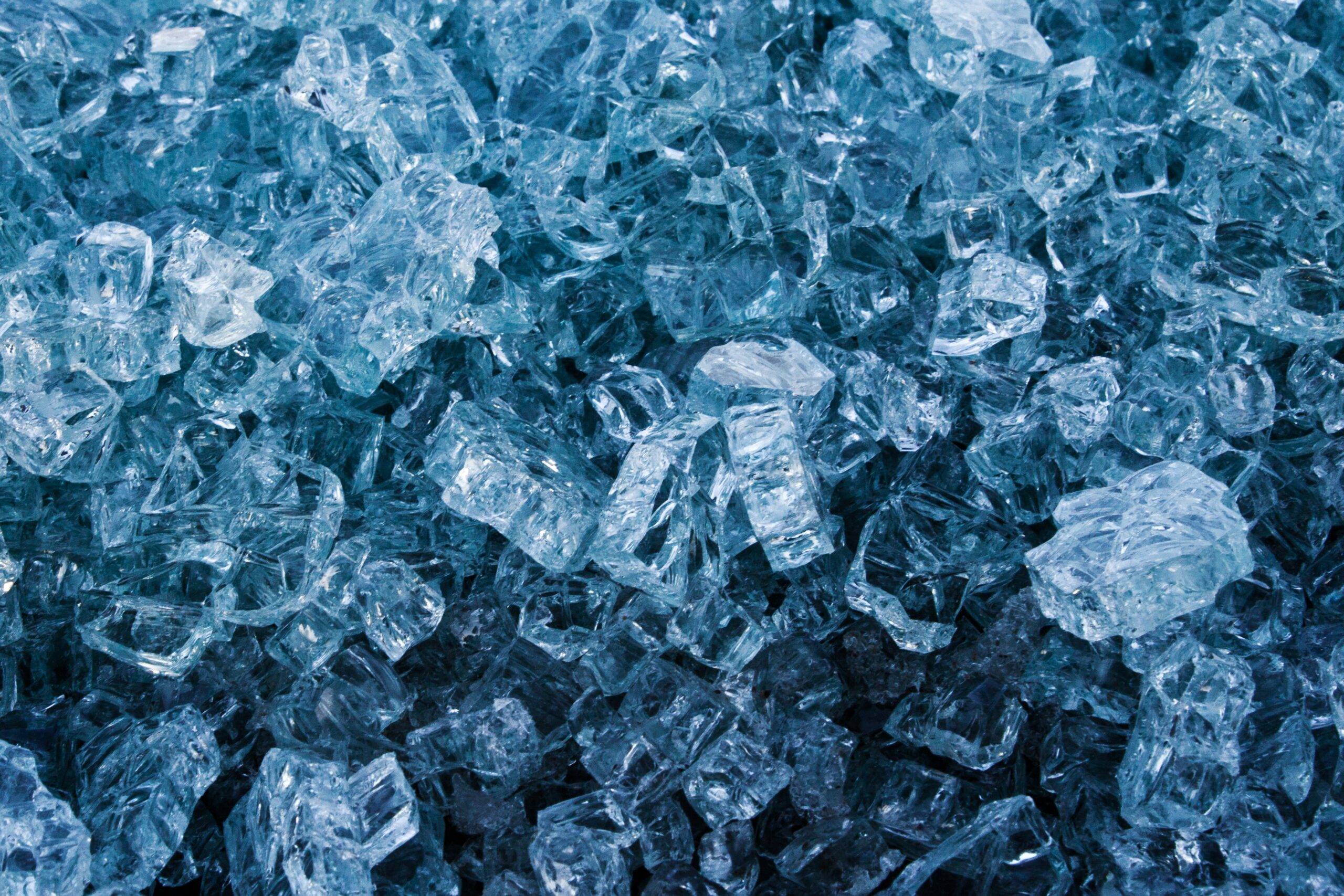
Congratulations to more than 1,000 courageous runners who finished the 28th Annual Steamtown Marathon today. Most, if not all of you, will wake up tomorrow morning with a little less jump in your step than you had yesterday to begin your recovery.
As active people by nature, many of you will resist the logic of rest, despite the pain and stiffness in your muscles and joints. Therefore, I would like to offer some words of wisdom, based on science, to encourage you to adequately rest and allow your body to recover.
With adequate rest and recovery, an elite runner can quickly regain full form in 3-4 weeks, while an average runner may require 4-6 weeks. Meb Keflezighi, an elite American runner and winner of the 2014 Boston Marathon, is an excellent example of the merits of rest and recovery. However, he discovered it by accident…following the 2012 New York City Marathon, Meb developed a foot infection which required three weeks rest. With the Olympic Trials just 70 days away, Meb quickly regained his pre-injury fitness level to win the 2012 US Olympic Marathon Trials and join the US Olympic Team in London. It may be that his injury was fortuitous and allowed him adequate recovery time, (that he might not have otherwise allowed), preparing him for intensive training leading up to the trials.
The Effects of Running 26.2 Miles on the Body: (RunNow.com - Jim Peskett)
One of the most obvious effects of running a marathon is significant muscle and joint pain and stiffness. It will set in after you sit for a while and attempt to get up and move around. For most, it will be more pronounced the day after the marathon, as you get out of bed and limp to the bathroom. Studies show that the leg muscles, (especially the calf muscles) display significant inflammation and necrosis (dead tissue) in the fibers of the muscle. In other words, the trauma to the muscles is so severe that tissue damage causes muscle cells to die. Consequently, studies found that muscle strength, power and endurance is compromised and required significant time to recover… sometimes as long as 4-6 weeks!
Additionally, many runners report severe bone and joint pain following the race. Some studies report findings of microfractures or bone bruising from the repeated and prolonged pounding of the marathon. It is purported that the stress on the joints may be related to: weight and body type, running shoes, running style and mechanics. While not dangerous, again, it is important to respect the stress placed on the body and allow adequate healing…LISTEN TO YOUR BODY!
Creatine kinase is an enzyme found in the brain, skeletal muscles and heart. It is found in elevated levels in the presence of cellular damage to these tissues, for example, following a heart attack. Similarly, significantly elevated creatine kinase levels are found in the blood of runners up to 4 days post marathon, demonstrating extensive tissue damage at the cellular level. It is important to note, that these enzyme markers are present, even if a runner does not experience muscle soreness. So, adequate rest for healing and recovery is required, regardless of soreness.
It is not a coincidence that the runners are more likely to contract colds and flu after intensive training or running 26.2 miles. The immune system is severely compromised after a marathon and without adequate recovery; a runner can become ill and ultimately lose more training time or will underperform.

EVERY MONDAY – Read Dr. Paul J. Mackarey “Health & Exercise Forum!” via Blog
EVERY SUNDAY in "The Sunday Times" - Read Dr. Paul J. Mackarey “Health & Exercise Forum!” in hard copy
This article is not intended as a substitute for medical treatment. If you have questions related to your medical condition, please contact your family physician. For further inquires related to this topic email: drpmackarey@msn.com
Paul J. Mackarey PT, DHSc, OCS is a Doctor in Health Sciences specializing in orthopedic and sports physical therapy in Scranton and Clarks Summit. Dr. Mackarey is in private practice and is an associate professor of clinical medicine at Geisinger Commonwealth School of Medicine. For all of Dr. Mackarey's articles, visit our exercise forum!
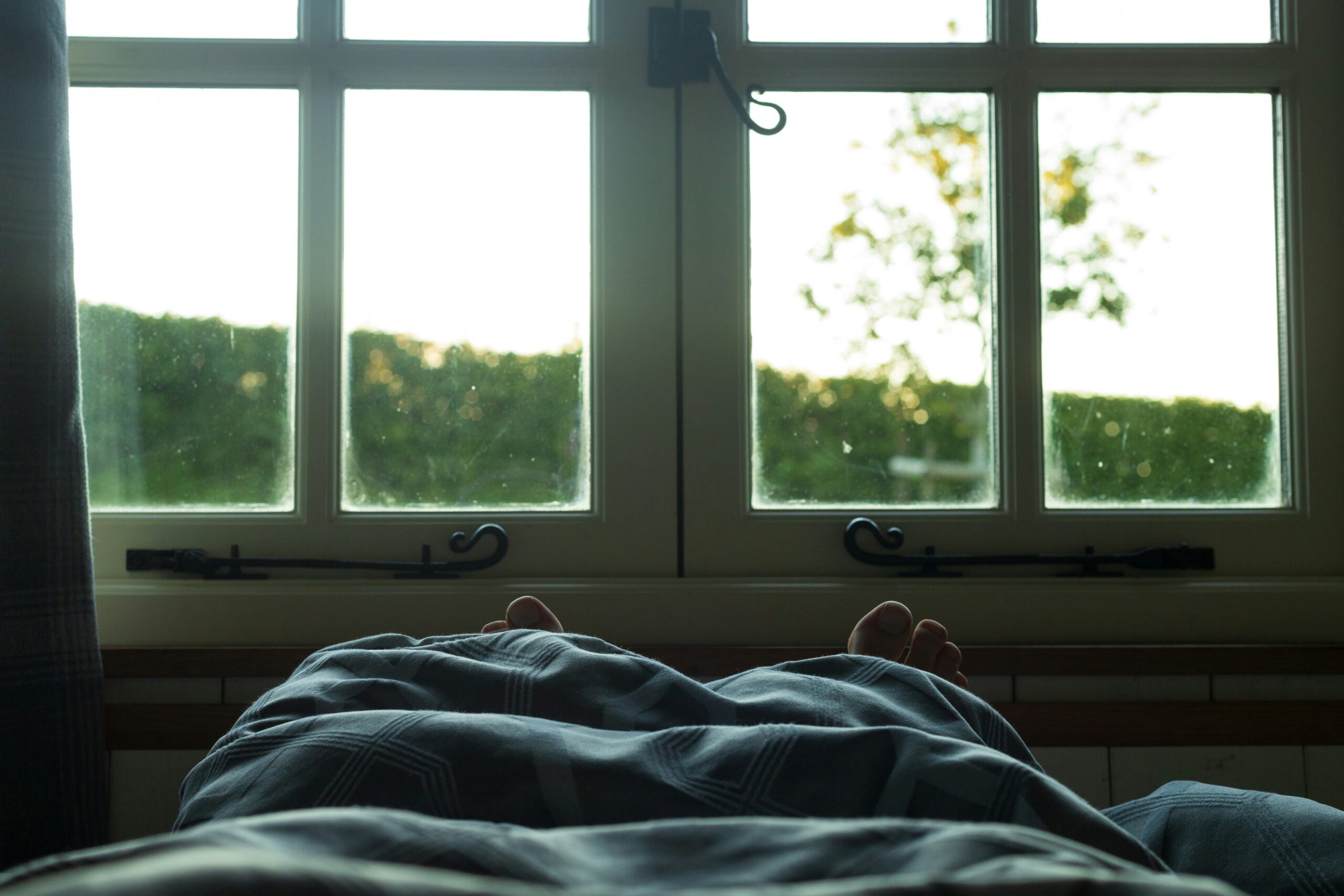
Here are 10 most common exercise myths!

EVERY MONDAY – Read Dr. Paul J. Mackarey “Health & Exercise Forum!” via Blog
EVERY SUNDAY in "The Sunday Times" - Read Dr. Paul J. Mackarey “Health & Exercise Forum!” in hard copy
This article is not intended as a substitute for medical treatment. If you have questions related to your medical condition, please contact your family physician. For further inquires related to this topic email: drpmackarey@msn.com
Paul J. Mackarey PT, DHSc, OCS is a Doctor in Health Sciences specializing in orthopedic and sports physical therapy in Scranton and Clarks Summit. Dr. Mackarey is in private practice and is an associate professor of clinical medicine at Geisinger Commonwealth School of Medicine. For all of Dr. Mackarey's articles, visit our exercise forum!
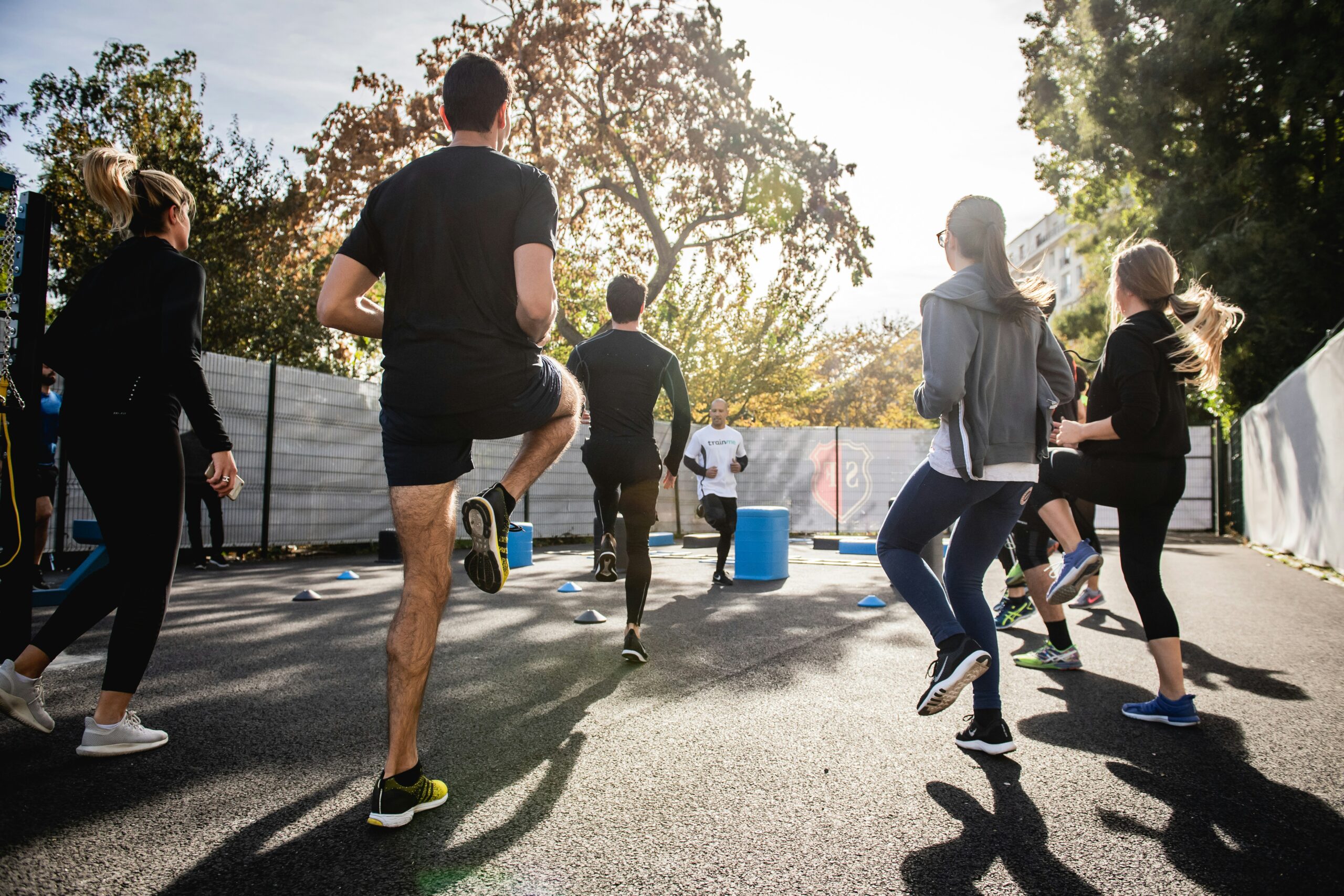
September is National Yoga Month! It is hard to believe that yoga, which is now a cultural mainstay, was once considered a foreign practice. An ancient discipline that totes numerous health benefits, it is meant to cultivate inner peace, enlightenment, and a strong relaxed body. In the past, only major cities housed yoga studios but over time it has spread into small towns across the country. Studios offer a variety of classes and each promotes their own unique philosophy. Whether you are looking for a new workout regime, compliment to your current program or simply to quiet your mind in a hectic world, yoga may be an option for you.
Yoga is a discipline that developed over 5,000 years ago and is generally recognized as an ancient system for wellbeing. The word yoga, from the Sanskrit word “yuj”, literally means to yoke or to bind together. The primary focus is to harmonize or unite the mind, body, and spirit through a combination of poses, breathing techniques, and meditation.
The specific origin of it is a topic of debate. However, it is said to have originated in India and was brought to the Western world by gurus in the late 19th and early 20th centuries. The basis for most current practices is The Yoga Sutras of Patanjali. In The Yoga Sutras, eight limbs of yoga are specified. The three most common limbs are meditation, pranayama or breathing exercises, and asana which are the physical poses. Classes can vary greatly, however, most classes include a combination of meditation, breathing exercises, and physical postures.
There are numerous styles of yoga. If you are a newcomer, deciding on a class may be difficult. It is always a smart idea to call a studio before attending a class to gain information and have any questions answered. Furthermore, if you have any health concerns you may want to consult your doctor prior to trying a new form of exercise. Some common forms include but are not limited to:
Below you can find a few common poses or asanas that can be found in beginner classes. These poses promote flexibility and strength and can be incorporated into your everyday workout routine. Remember, before you attempt the poses, begin by walking, biking or running to warm up. Don’t overstretch, perform slowly, and hold the position. You should feel mild discomfort NOT pain.
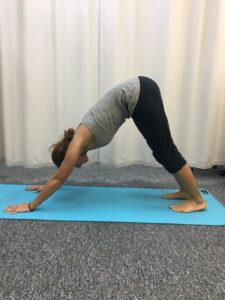
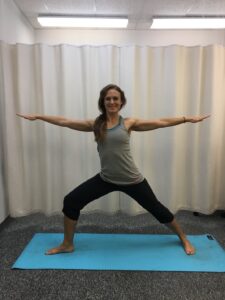
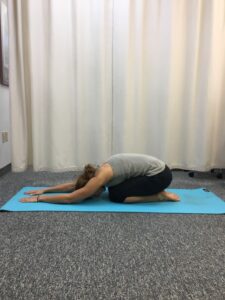
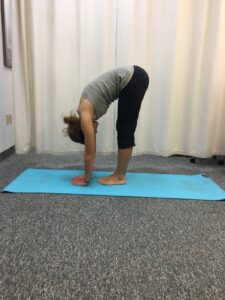
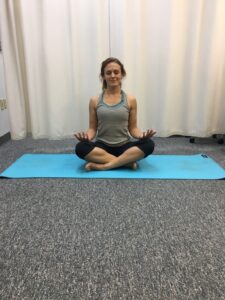
There are a lot of options when it comes to where to start to practice. It is important that the studio you choose employs certified yoga instructors who have completed comprehensive training. A good instructor can make all the difference in your experience. The studio should provide a clean environment and offer a variety of classes including beginner level if you are a newcomer. The best way to get a feel for a studio is to stop in for more information. You may want to ask about pricing as there are often discount introductory rates. Ask about rentals if you do not own a yoga mat and request to see the space. Some yoga studios have a strong sense of community while others are more like a gym. Try out a few different places until you find a fit for you.
Guest Columnist: Catherine Udomsak, PT, DPT | Model: Sarah Singer, PTA

EVERY MONDAY – Read Dr. Paul J. Mackarey “Health & Exercise Forum!” via Blog
EVERY SUNDAY in "The Sunday Times" - Read Dr. Paul J. Mackarey “Health & Exercise Forum!” in hard copy
This article is not intended as a substitute for medical treatment. If you have questions related to your medical condition, please contact your family physician. For further inquires related to this topic email: drpmackarey@msn.com
Paul J. Mackarey PT, DHSc, OCS is a Doctor in Health Sciences specializing in orthopedic and sports physical therapy in Scranton and Clarks Summit. Dr. Mackarey is in private practice and is an associate professor of clinical medicine at Geisinger Commonwealth School of Medicine. For all of Dr. Mackarey's articles, visit our exercise forum!

September is National Yoga Month! It is hard to believe that yoga, which is now a cultural mainstay, was once considered a foreign practice. An ancient discipline that totes numerous health benefits, yoga is meant to cultivate inner peace, enlightenment, and a strong relaxed body. In the past, only major cities housed yoga studios but over time yoga has spread into small towns across the country. Studios offer a variety of classes and each promotes their own unique philosophy. Whether you are looking for a new workout regime, compliment to your current program or simply to quiet your mind in a hectic world, yoga may be an option for you.
Yoga is a discipline that developed over 5,000 years ago and is generally recognized as an ancient system for well-being. The word yoga, from the Sanskrit word “yuj”, literally means to yoke or to bind together. The primary focus of yoga is to harmonize or unite the mind, body, and spirit through a combination of poses, breathing techniques, and meditation.
The specific origin of yoga is a topic of debate. However, it is said to have originated in India and was brought to the Western world by yoga gurus in the late 19th and early 20th centuries. The basis for most current yoga practices is The Yoga Sutras of Patanjali. In The Yoga Sutras, eight limbs of yoga are specified. The three most common limbs are meditation, pranayama or breathing exercises, and asana which are the physical poses. Yoga classes can vary greatly, however, most classes include a combination of meditation, breathing exercises, and physical postures.
So what is with all the hype? Why has yoga become so popular? Many would say it is due to its numerous mental and physical health benefits. Research has shown that yoga, when practiced regularly, can reduces stress levels and even boost one’s immune system. Regular stretching releases tension in the body and the controlled breathing and mediation decrease anxiety. Studies show that those who practice yoga habitually can have decreased blood pressure and cholesterol making them less prone to heart disease. Other ailments which are shown to be positively impacted by yoga include insomnia, depression, and chronic pain including low back pain and headaches. Yoga is an excellent way to combat the negative effects of stress on the body and cope with anxiety and angst.
In addition to stress reduction, yoga has many physical benefits. These include increased flexibility, strength, and balance. Those who practice yoga regularly are often less prone to injury, such as a muscle strain or tear, due to their increased flexibility. Furthermore, yoga can be an effective way to strengthen one’s core which is crucial to maintaining ideal posture and protecting the back. For athletes, yoga can be a great way to challenge one’s balance and improve stability. In the elderly, it is a safe way to improve overall body awareness and decrease the risk of falling. Yoga has also been shown to improve respiration and many report an overall increase in energy when incorporating yoga into their lives.
With all of the positive impacts yoga has on the body it is easy to see why it has become such a popular form of exercise. There are classes to meet almost all needs and most poses can be modified based on ability. Yoga can be practiced by those of all ages and all fitness levels. Whether you’re looking for a way to loosen up tight muscles or you simply wish to quiet your mind for an hour, yoga is a tool to improve and maintain health. The only thing you need is a mat and an open mind.
Yoga can be practiced by anyone. From children to adults to the elderly, there are classes for all ages and abilities. It can be a form of cross training for athletes, especially runners who tend to have tight musculature. It also promotes balance and core stability which may be beneficial to sportspersons including football players, soccer players, boxers, etc. Furthermore, there are classes for the elderly which focus on balance and maintaining mobility. There are even prenatal yoga classes for pregnant women to promote deep breathing, flexibility and muscle tone.
Next Week: Types of Yoga and Basic Poses
Guest Columnist: Catherine Udomsak, PT, DPT

EVERY MONDAY – Read Dr. Paul J. Mackarey “Health & Exercise Forum!” via Blog
STAY TUNED for Yoga: TYPES OF YOGA AND BASIC POSES: Part II of II!
EVERY SUNDAY in "The Sunday Times" - Read Dr. Paul J. Mackarey “Health & Exercise Forum!” in hard copy
This article is not intended as a substitute for medical treatment. If you have questions related to your medical condition, please contact your family physician. For further inquires related to this topic email: drpmackarey@msn.com
Paul J. Mackarey PT, DHSc, OCS is a Doctor in Health Sciences specializing in orthopedic and sports physical therapy in Scranton and Clarks Summit. Dr. Mackarey is in private practice and is an associate professor of clinical medicine at Geisinger Commonwealth School of Medicine. For all of Dr. Mackarey's articles, visit our exercise forum!

Happy Labor Day! There is little doubt that the workplace has been redefined since the pandemic as many employees continue to work from home. Sitting for many hours at a workstation that may not be optimal has also changed the way we define workplace health and safety. It may be more important than ever to pay close attention to designing an ergonomic workstation, changing position, and stretching regularly to prevent injury.
Since 1894 Labor Day has been designated as the national holiday that pays tribute to the contributions and achievements of American workers. Research supports the notion that healthier employees are happier and more productive. When employers encourage healthy behavior and safety at work, they benefit in many ways.
For example, in addition to improving job satisfaction and productivity, healthy employees save money by using less sick time, worker’s compensation benefits and health benefits. For example, according to the Centers for Disease Control and Prevention, approximately 75 percent of employers” health care costs are related to chronic medical problems such as obesity, diabetes, high blood pressure, and high cholesterol. Deconditioned, overweight employees are more likely to suffer from these preventable conditions and are at greater risk for injury. Employers, please consider using this holiday as an opportunity to start a health promotion program at your workplace…have a health fair, offer healthy snacks, encourage walking, smoking cessation, exercising at lunch, and offer fitness club stipends.
Lower back pain, one of the costliest illnesses to employers, is one example of a problem which can be prevented with a good health and safety program. It is widely accepted in the medical community that the best treatment for lower back pain (LBP) is prevention. Keeping fit, (flexible and strong), practicing good posture, and using proper body mechanics are essential in the prevention of LBP. At our clinic, significant time and effort is spent emphasizing the importance of these concepts to our patients, employees, and the businesses we work with through industrial medicine programs. A comprehensive approach can produce significant reductions in LBP injuries through an onsite safety program which promotes education, wellness, body mechanics, lifting techniques, postural and stretching exercises and ergonomics.
As little as 10 extra pounds puts great stress on your lower back. It also makes it more difficult to maintain good posture. Eat well, exercise regularly and don’t smoke. Smokers have a much higher incidence of LBP and failure from lower back surgery.
Good posture is critical for a healthy back. When sitting, standing or walking maintain a slight arch in your lower back, keep shoulders back, and head over your shoulders. In sitting, use a towel roll or small pillow in the small of the back. Also, consider sitting on a physio ball, which promotes proper posture for part of the day.
Perform postural exercises throughout the day. Most of the day we sit, stand, and reaching forward and bend our spine. These exercises are designed to stretch your back in the opposite direction of flexion. Please perform slowly, hold for 3-5 seconds and repeat 6 times each 6 times per day.
Chin Tuck: Tuck your chin back to bring your head over shoulders.
Shoulder Blade Pinch: Pinch your shoulder blades together.
Standing Extension: While standing, put your hands behind back and extend lower back 10-20 degrees.
Good Body Mechanics and ergonomics are also important in the prevention of LBP. When lifting, think twice. Think about the weight, shape and size of the object. Think about where the object is going and the surface resistance of the floor. Does it require two people to lift? Can I safely lift that high or bend that low?
When bending to lift an object think about safety:
Visit your doctor regularly and listen to your body.

EVERY MONDAY – Read Dr. Paul J. Mackarey “Health & Exercise Forum!” via Blog
EVERY SUNDAY in "The Sunday Times" - Read Dr. Paul J. Mackarey “Health & Exercise Forum!” in hard copy
This article is not intended as a substitute for medical treatment. If you have questions related to your medical condition, please contact your family physician. For further inquires related to this topic email: drpmackarey@msn.com
Paul J. Mackarey PT, DHSc, OCS is a Doctor in Health Sciences specializing in orthopedic and sports physical therapy in Scranton and Clarks Summit. Dr. Mackarey is in private practice and is an associate professor of clinical medicine at Geisinger Commonwealth School of Medicine. For all of Dr. Mackarey's articles, visit our exercise forum!

The number one health and wellness goal shared by most patients is …to lose weight! Today, this column will offer some sage and practical advice on satisfying hunger with healthy snacks and to help avoid unhealthy carbs. You have probably noticed a lot of attention being paid to sugar lately. In fact, some people have decided to avoid all refined sugars with the goal of improving their health and wellness. Terms like simple sugars and simple carbs, which are purported to be bad, and complex carbs, suggested to be good, are being used ad nauseam. While medical research does not support the value of a short term “sugar cleanse,” it may have value for another reason. For example, it would be very beneficial if one engages in a “sugar cleanse” for the purpose of changing their palate with the hope of developing long term healthy eating habits.
While I am an advocate of moderation, I decided to provide my readers with some answers to some simple questions about the fuss over sugar. What is simple sugar? What is complex sugar? Which sugars are good for you? What are some good low-carb snacks?
Sugars, along with starches and fibers, are one of three types of carbohydrates (also referred to as a carb). A carb is “simple” or “complex,” based on its chemical composition and how it is processed in the body. It gets a little complicated because some foods have both simple and complex carbs. Typically, simple carbs are chemically “simpler” and more basic. Therefore they are broken down more easily and serve as a quick source of energy. Some of these carbs are naturally simple (like fruit and milk) while others are processed or refined sugars such as those used in candy, soda and baked goods.
To determine if a food product has good or bad simple sugar, you must also know how much fiber, vitamins and minerals are in the food. A food with a higher sugar content combined with a low fiber, vitamin or mineral content will be worse than a food with the same sugar content but high fiber and vitamins or minerals. For example: a candy bar, which is high in sugar without fiber or vitamins or minerals, is not as healthy as a fresh orange, which contains fiber, vitamins and minerals along with its simple sugar (fructose).
Examples of simple carbs:
Most candy products, non-diet soft drinks, cookies and cakes, iced tea and lemonade with sugar, energy drinks, and ice cream.
Complex carbs have a more complicated chemical makeup and take more time for the body to break down for use as energy. Therefore, these are considered “good” carbs because they provide a more even distribution of energy for the body to use during activity. They cause a more consistent and gradual release of sugar into the blood stream (as opposed to peaks and valleys caused by simple carbs) and provide energy to function throughout the day. Additionally, “good” carbs have the added benefit of providing vitamins, fiber, and minerals that are missing from simple carbs.
Remember that carbohydrates fuel the body and are an important source of energy, especially for active and athletic people. However, carefully selecting the type of carb you eat is critical to peak function and performance.
Simple carbs taste great (according to our modern brain raised on simple sugars) and are easy to break down into a quick source of energy. However, the sensation of hunger is quick to return because the sugar is released and used up in the body quickly, giving the sensation of needing more.
Simple carbs are often “refined.” Therefore stripped of their fiber, vitamins and minerals, which is why they are often referred to “empty” calories.
Simple carbs lead to rapid spikes in blood sugar and insulin levels after meals. When these levels are not controlled over time, it can lead to obesity. Ultimately relates to adult-onset diabetes and high blood pressure.
Sources: webMD, NIH, CDC

EVERY MONDAY – Read Dr. Paul J. Mackarey “Health & Exercise Forum!” via Blog
EVERY SUNDAY in "The Sunday Times" - Read Dr. Paul J. Mackarey “Health & Exercise Forum!” in hard copy
This article is not intended as a substitute for medical treatment. If you have questions related to your medical condition, please contact your family physician. For further inquires related to this topic email: drpmackarey@msn.com
Paul J. Mackarey PT, DHSc, OCS is a Doctor in Health Sciences specializing in orthopedic and sports physical therapy in Scranton and Clarks Summit. Dr. Mackarey is in private practice and is an associate professor of clinical medicine at Geisinger Commonwealth School of Medicine. For all of Dr. Mackarey's articles, visit our exercise forum!

Despite recent challenges for air travel due to increased volume, severe weather and a nationwide shortage of air traffic controllers, Americans report high levels of enthusiasm for air travel this summer, including travel abroad.
Confession; I recently was on a long trip that required sitting on an airplane for more than six hours…and I wore compression stockings … guess I’m getting older (and wiser)!
Have you noticed that being in a car or on an airplane for more than three hours leads to neck and back pain? Soreness, stiffness and swelling in your legs? With a little planning, preventing or limiting these problems on long trips is possible. Also, as people age and/or develop other health problems, they are more vulnerable to developing a more serious problem associated with long trips; deep vein thrombosis (DVT) or blood clots. But problems with long-distance travel can be avoided. The following tips, based on research and personal experience, can prevent neck, back and leg pain and stiffness and DVT.
A DVT is a blood clot that forms in a deep vein. The deep veins pass through the muscles and cannot be seen like the veins just under your skin. While it may occur in your arms, it is much more common in the legs, especially the calf muscle when traveling. When a blood clot forms in a leg vein it usually sticks to the vein wall. Often, pain and swelling lead you to the doctor and treatment is rendered before serious complications develop. However, there are two possible complications. One, a pulmonary embolus, occurs when a part of the clot logged in your deep vein of the calf breaks off and gets lodged in the lung. This is a very serious problem that can be fatal. Two, post-thrombotic syndrome, occurs when you have pain and swelling in your calf after a DVT.
The following risk factors for DVT significantly increase the potential for problems when traveling on long trips by air, more than 5 hours. Trains, cars and buses also create a risk, but air travel creates a greater risk for the following reasons: reduced cabin pressure, reduced cabin oxygen levels, dehydration and alcoholic drinks, which may increase dehydration and immobility.
Airplane seats are “C” shaped and force you to round your neck and back forwards. These exercises are designed to stretch and extend your back in the opposite direction. Please perform slowly, hold for 3-5 seconds and repeat 10 times each hour.
Sitting:
When sitting in an airplane seat, take the neck pillow in the overhead compartment and place it in the small of your lower back. While sitting or standing up, perform postural exercises every 30-45 minutes.
Visit your doctor regularly and listen to your body.

EVERY MONDAY – Read Dr. Paul J. Mackarey “Health & Exercise Forum!” via Blog
EVERY SUNDAY in "The Sunday Times" - Read Dr. Paul J. Mackarey “Health & Exercise Forum!” in hard copy
This article is not intended as a substitute for medical treatment. If you have questions related to your medical condition, please contact your family physician. For further inquires related to this topic email: drpmackarey@msn.com
Paul J. Mackarey PT, DHSc, OCS is a Doctor in Health Sciences specializing in orthopedic and sports physical therapy in Scranton and Clarks Summit. Dr. Mackarey is in private practice and is an associate professor of clinical medicine at Geisinger Commonwealth School of Medicine. For all of Dr. Mackarey's articles, visit our exercise forum!

Farmers and gardeners in NEPA always say that Memorial Day, the “kick off” day for planting without the fear of frost, however, this year we have had an unusually cold and wet spring… but it is not too late to start…not only for the beds but your body! While gardeners are anxious to work in their gardens and enjoy the fruits of their labor, a relaxing and enjoyable activity can turn dangerous quickly. Precautions are necessary as repetitive stress injuries such as shoulder and elbow tendonitis and carpal tunnel syndrome can stem from raking, weeding, digging and pruning. Additionally, simple scrapes, blisters, and bites can turn into serious problems if not treated appropriately. Since prevention is the best approach, the American Society of Hand Therapists (ASHT) promotes warm-up exercises and injury prevention tips to help all levels of gardeners avoid serious and long-term injuries while enjoying this popular outdoor activity.
ASHT recommends following these upper extremity warm-up exercises prior to gardening:
Note: These exercises should never be painful when completing them. You should only feel a gentle stretch. Hold 10 seconds and repeat 5 times. Should you experience pain, please consult a physician or hand therapist.
ASHT recommends the following guidelines to prevent injury and foster healthy gardening practices:
Professional Contributor: Nancy Naughton, OTD, CHT, is an occupational therapist and certified hand therapist practicing in NEPA.

Next Week: “Prevention of Gardening Injuries” Part II of II.
EVERY MONDAY – Read Dr. Paul J. Mackarey “Health & Exercise Forum!” via Blog
EVERY SUNDAY in "The Sunday Times" - Read Dr. Paul J. Mackarey “Health & Exercise Forum!” in hard copy
This article is not intended as a substitute for medical treatment. If you have questions related to your medical condition, please contact your family physician. For further inquires related to this topic email: drpmackarey@msn.com
Paul J. Mackarey PT, DHSc, OCS is a Doctor in Health Sciences specializing in orthopedic and sports physical therapy in Scranton and Clarks Summit. Dr. Mackarey is in private practice and is an associate professor of clinical medicine at Geisinger Commonwealth School of Medicine. For all of Dr. Mackarey's articles, visit our exercise forum!
